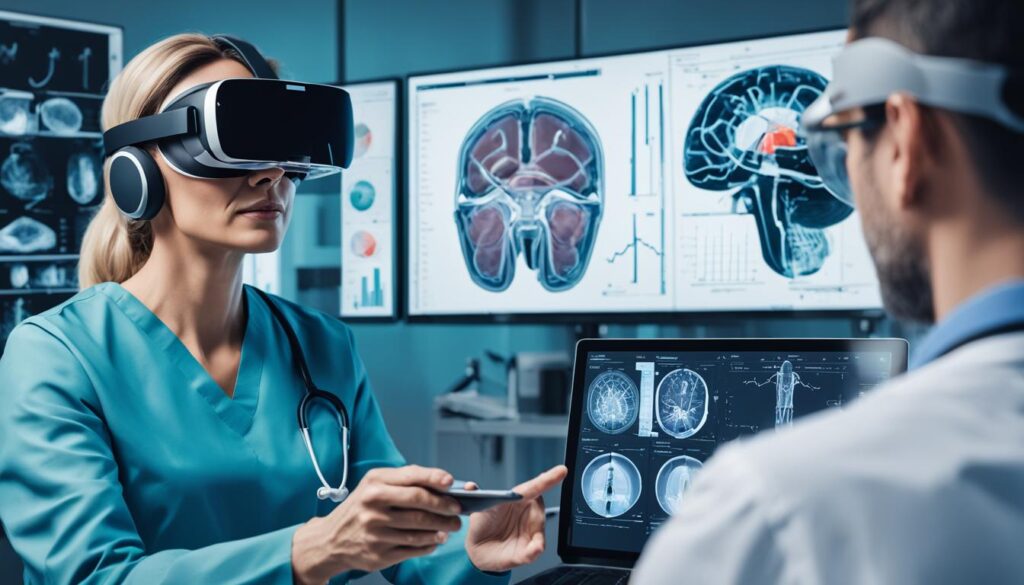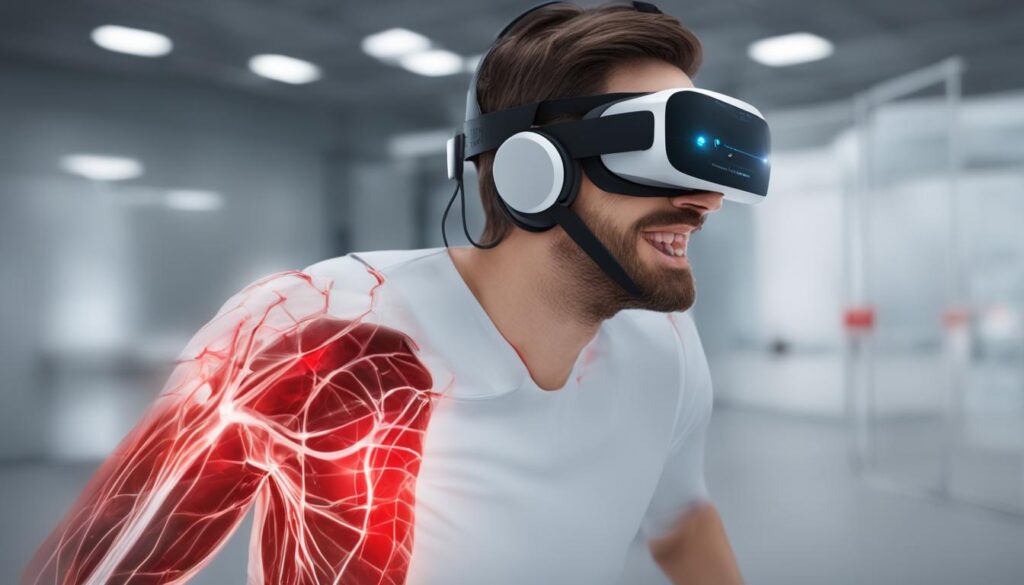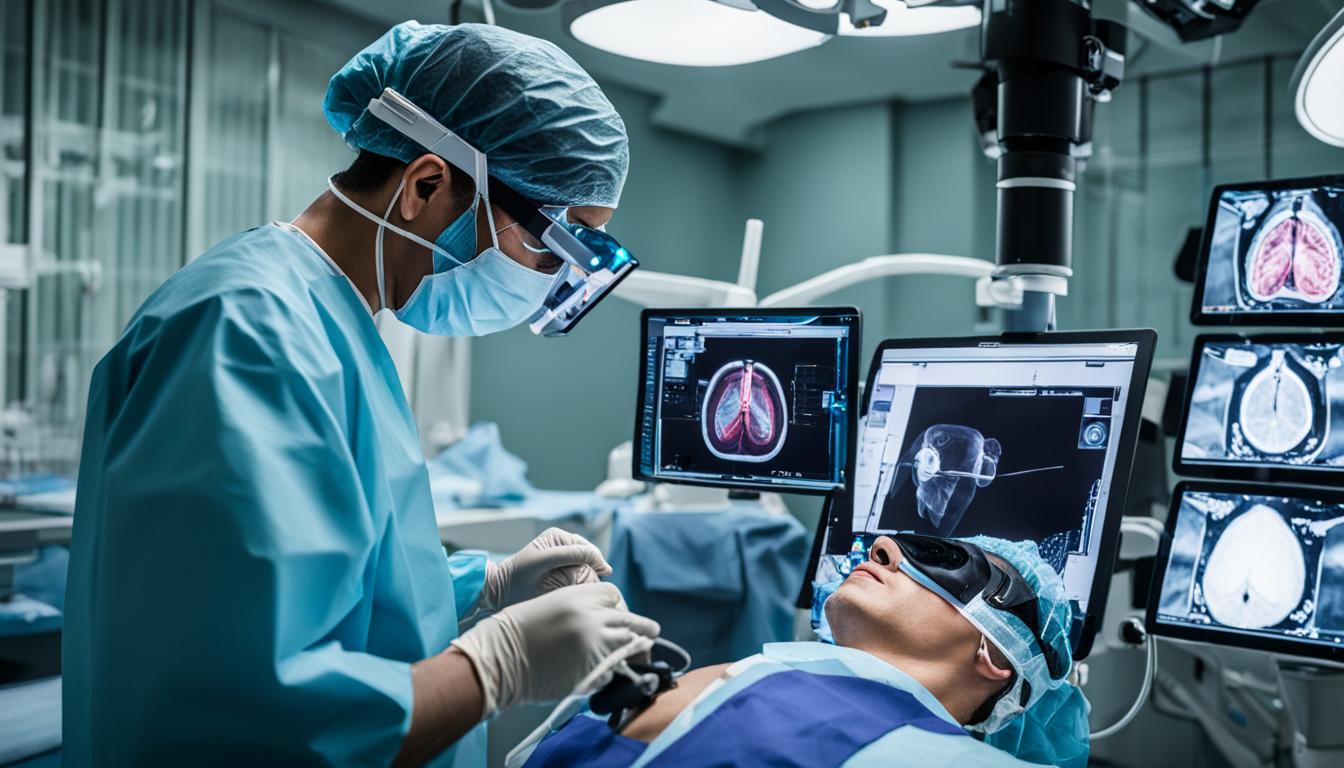Augmented reality (AR) is revolutionizing the healthcare industry, bringing new possibilities to medicine and surgery. The integration of AR technology in healthcare has opened up a world of opportunities, allowing healthcare providers to visualize information in real-time and improve patient care and outcomes. From surgical training to medical education, AR is transforming healthcare delivery.
In 2020, the first-ever spine surgery using an AR, head-mounted display was performed, paving the way for a new era in surgical procedures. Since then, neurosurgeons have utilized AR in hundreds of surgeries, with the potential for all surgeries to be performed with AR technology. By superimposing computer imagery on the real world, AR provides healthcare professionals with enhanced visualization capabilities.
AR has found its application in surgical training, enabling surgeons to practice complex procedures in a virtual environment. Medical visualization is another area where AR is making an impact. AR tools allow healthcare providers to superimpose visuals on patients, enhancing the delivery of safer care beyond the operating room. In patient diagnosis, AR assists doctors in understanding patients’ symptoms by providing visual references, leading to faster and more accurate diagnoses.
Moreover, AR has proven valuable in pain management, immersing patients in therapeutic environments and offering cognitive behavioral therapy to alleviate discomfort. The potential of AR in healthcare is vast, and it continues to drive innovation in healthcare delivery and improve patient outcomes.
Contents
- 1 AR in Surgery
- 2 AR in Medical Visualization
- 3 AR in Pain Management
- 4 Conclusion
- 5 FAQ
- 5.1 In what areas of medicine or surgery has augmented reality been most useful?
- 5.2 How is augmented reality used in surgery?
- 5.3 How is augmented reality used in medical visualization?
- 5.4 How is augmented reality used in patient diagnosis?
- 5.5 How is augmented reality used in pain management?
- 5.6 What is the future potential of augmented reality in medicine and surgery?
- 6 Source Links
Key Takeaways:
- Augmented reality (AR) is transforming the healthcare industry, with applications in medicine and surgery.
- AR technology allows healthcare providers to visualize information in real-time, leading to improved patient care and outcomes.
- AR is used in surgical training, medical visualization, patient diagnosis, and pain management.
- AR has the potential to revolutionize healthcare delivery and enhance medical training and research.
- The future of AR in medicine and surgery is promising, with continued advancements and innovations in this field.
AR in Surgery
In the field of surgery, augmented reality (AR) is making significant advancements, revolutionizing the way surgeons operate and enhancing patient outcomes. Surgeons now have the ability to utilize AR headsets during procedures, enabling them to access crucial information without diverting their attention from the operating table. This breakthrough technology combines AR with cameras and AI software, allowing surgeons to view real-time patient imagery, process complex data, and receive on-the-fly diagnoses or procedural suggestions.
AR is particularly valuable in robotic-assisted surgery, providing surgeons with an advanced interface that enhances their perception and decision-making abilities in real-time. With AR, surgeons can improve situational awareness, enabling them to navigate and perform complex procedures with greater precision. For instance, AR-guided procedures in hepatic surgery and liver resections have showcased the potential of AR to drastically improve surgical accuracy and patient safety.
One notable example of AR technology in surgery is the xvision Spine System, which allows surgeons to have “X-ray vision” during operations. This innovative imaging and guidance system overlays augmented reality imaging onto the surgeon’s field of view, providing enhanced visualization and increasing accuracy in surgical procedures.
As AR continues to evolve, its applications in surgery will likely expand, paving the way for even more advanced AR-assisted procedures. Surgeons wearing AR headsets, equipped with powerful AI software and imaging capabilities, can perform surgeries with improved precision and proficiency. With augmented reality technology guiding their every move, surgeons are entering a new era of surgical innovation and patient care.
AR in Medical Visualization
AR technology is advancing medical visualization, providing healthcare providers with innovative tools to enhance patient care beyond the operating room. By superimposing visuals on patients, AR overlays offer invaluable insights and improve accuracy in various healthcare settings. From medication administration to patient education, AR has the potential to revolutionize the way healthcare providers visualize and interact with patients.

Quote:
“AR technology revolutionizes the diagnostic process by enabling patients to visualize their symptoms and doctors to make more informed decisions. It enhances communication and leads to faster, more accurate diagnoses.”
Benefits of AR in Patient Diagnosis
- Improved communication between patients and doctors
- Faster and more accurate diagnoses
- Enhanced visualization of symptoms
- Personalized treatment plans
AR technology holds great potential in patient diagnosis, augmenting the capabilities of healthcare providers to accurately assess and address medical conditions. By leveraging AR for symptom visualization in a patient-centric approach, healthcare professionals can enhance the diagnostic process and provide more effective care.
AR in Pain Management
Augmented reality (AR) has the potential to revolutionize pain management by providing immersive experiences in therapeutic environments. Similar to virtual reality (VR), AR technology can be used to deliver cognitive behavioral therapy, helping patients relax and cope with pain.
During physical therapy sessions, AR can minimize discomfort and personalize pain management experiences. By overlaying digital elements onto the real-world environment, AR enables patients to engage in therapeutic exercises with enhanced guidance and support.
Benefits of AR in Pain Management
AR in pain management offers several benefits:
- Enhanced relaxation and stress reduction
- Improved engagement and motivation during physical therapy
- Personalized pain management experiences
- Real-time feedback and guidance
The combination of AR and artificial intelligence (AI) has the potential to create personalized pain management solutions. By analyzing patient data and adapting therapy programs in real-time, AR can optimize treatment outcomes.

AR for Cognitive Behavioral Therapy
“AR provides a unique opportunity to merge psychological techniques with immersive experiences, allowing patients to visualize their progress and develop effective coping mechanisms.” – Dr. Sarah Thompson, PsyD
Cognitive behavioral therapy (CBT) is an evidence-based approach to pain management. AR can enhance CBT by providing a visual and interactive platform for patients to practice relaxation techniques, challenge negative thoughts, and reframe their pain experience.
With AR, patients can simulate anxiety-provoking situations and gradually expose themselves to those experiences, ultimately reducing fear and increasing their pain tolerance. By integrating CBT principles into AR experiences, patients can develop essential skills to manage pain and improve their overall well-being.
AR in Physical Therapy
AR is increasingly being integrated into physical therapy practices to enhance pain management efforts. By augmenting the physical environment, AR can provide patients with visual cues, real-time feedback, and interactive exercises.
For example, during rehabilitation for a knee injury, AR can project a virtual representation of the patient’s leg on a screen. This visual aid helps patients align and position their leg correctly, ensuring optimal technique and reducing the risk of further injury.
AR can also create interactive and engaging experiences during exercises, motivating patients to complete their therapy sessions and maintain a consistent routine. By making physical therapy more enjoyable and effective, AR accelerates the recovery process and improves patient outcomes.
| Potential Benefits of AR in Physical Therapy | Examples |
|---|---|
| Improved exercise adherence | Interactive games and challenges that encourage patients to complete therapy sessions |
| Enhanced engagement and motivation | Virtual environments that simulate real-life scenarios relevant to the patient’s therapy goals |
| Real-time feedback and guidance | Visual overlays indicating correct form and technique during exercises |
| Personalized exercise programs | AR applications that adapt difficulty levels based on patient progress and capabilities |
AR technology has the potential to transform pain management, providing patients with engaging, personalized, and effective experiences. As research and development in AR continue to advance, we can anticipate further innovations and improvements in pain management practices.
Conclusion
Augmented reality (AR) has already started to revolutionize the healthcare industry, offering a multitude of applications in surgery, medical visualization, patient education, diagnosis, and pain management. The potential for AR in healthcare is immense, promising improved patient care, enhanced medical training, and innovative healthcare delivery.
With the continuous evolution of technology, AR has the power to transform healthcare by providing healthcare professionals with real-time information, personalized patient experiences, and better outcomes. As the future unfolds, we can expect to witness further advancements and innovations in the field of AR, paving the way for more efficient and effective healthcare practices.
As the adoption of AR technology expands, surgeons will have access to advanced AR headsets that provide vital patient information without the need to divert their attention from critical tasks. In addition, AR tools can enhance medical visualization, enabling healthcare providers to superimpose crucial visuals on patients in real-time, improving accuracy and efficiency in patient care.
Moreover, AR technology can significantly contribute to patient diagnosis by helping patients communicate their symptoms more effectively through visual aids. By visualizing skin conditions or eye conditions, doctors can improve their understanding of patient concerns, leading to faster and more accurate diagnoses. Furthermore, AR has the potential to transform pain management through immersive therapeutic experiences that aid in relaxation and coping mechanisms for patients.
FAQ
In what areas of medicine or surgery has augmented reality been most useful?
Augmented reality (AR) has been most useful in surgery, medical visualization, patient diagnosis, and pain management.
How is augmented reality used in surgery?
Augmented reality is used in surgery through the use of AR headsets, which allow surgeons to see information such as patient imagery without turning away from their critical tasks. AR technology, combined with cameras and AI software, enables surgeons to view what’s happening inside a patient, process data, and receive on-the-fly diagnoses or procedural suggestions.
How is augmented reality used in medical visualization?
Augmented reality is used in medical visualization through the development of AR tools that superimpose visuals on patients. This enhances the delivery of safer care by allowing healthcare providers to visualize a patient’s vein structure or other relevant information in real-time, improving accuracy and efficiency in patient care.
How is augmented reality used in patient diagnosis?
Augmented reality is used in patient diagnosis by helping patients accurately describe their symptoms. Patients can visualize different skin conditions or eye conditions through AR glasses, aiding doctors in understanding their concerns. This visualization aid enhances the communication between patients and doctors, leading to faster and more accurate diagnoses.
How is augmented reality used in pain management?
Augmented reality is used in pain management by immersing patients in therapeutic environments, similar to virtual reality (VR). AR technology provides cognitive behavioral therapy to help patients relax and cope with pain. AR can also be used during physical therapy sessions to minimize discomfort and personalize pain management experiences.
What is the future potential of augmented reality in medicine and surgery?
The potential of augmented reality in medicine and surgery is vast. It has the ability to revolutionize healthcare delivery, improve patient care and outcomes, and enhance medical training and research. As technology continues to develop, we can expect to see continued advancements and innovations in this field.
Source Links
- https://www.webmd.com/a-to-z-guides/features/augmented-reality-medicine
- https://www.fingent.com/blog/augmented-reality-in-healthcare-use-cases-examples-and-trends/
- https://www.forbes.com/sites/forbestechcouncil/2023/06/01/augmented-reality-is-already-changing-healthcare-for-the-better/?sh=e0c34a278518




